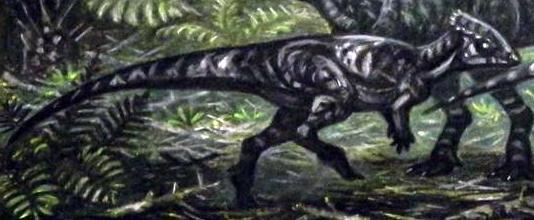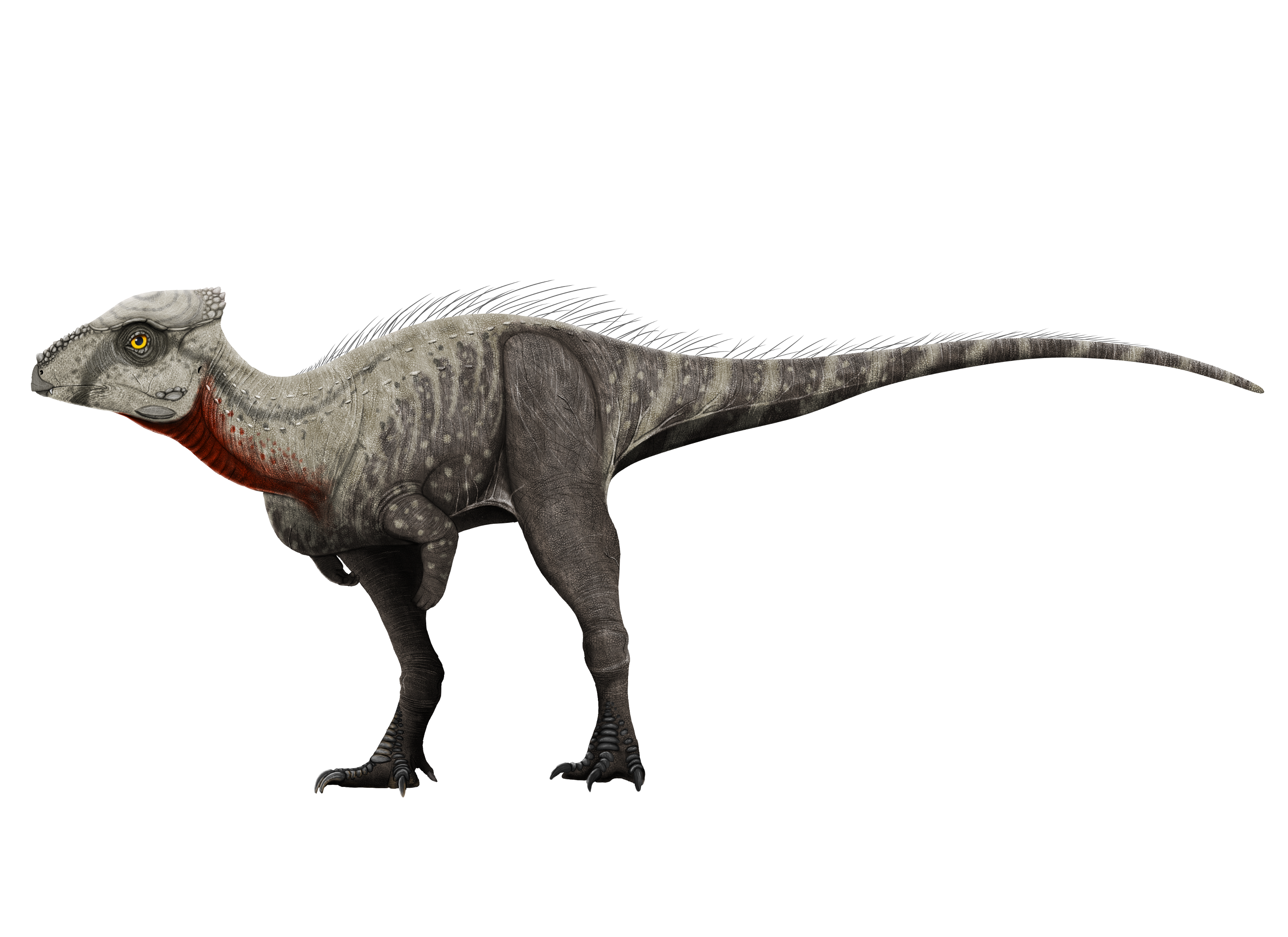|
Prenocephale Prenes
''Prenocephale'' (meaning "sloping head") is a genus of small pachycephalosaurid dinosaur from the Late Cretaceous Nemegt Formation of Mongolia. It was similar in many ways to its close relative, ''Homalocephale''. Description Adult ''Prenocephale'' measured in length and in body mass. Unlike the flattened wedge-shaped skull of ''Homalocephale'' (a possible juvenile trait also potentially seen in early growth stages of ''Pachycephalosaurus''), the head of ''Prenocephale'' was rounded and sloping. The dome had a row of small bony spikes and bumps. Like some other pachycephalosaurs, ''Prenocephale'' is known only from skulls and a few other small bones. For this reason, reconstructions usually depict ''Prenocephale'' as sharing the basic body plan common to all of the other Pachycephalosauria: a stout body with a short, thick neck, short forelimbs and tall hind legs. The head of ''Prenocephale'' was comparable to that of ''Stegoceras'', albeit with closed supratemporal fenestra ... [...More Info...] [...Related Items...] OR: [Wikipedia] [Google] [Baidu] |
Late Cretaceous
The Late Cretaceous (100.5–66 Ma) is the younger of two epochs into which the Cretaceous Period is divided in the geologic time scale. Rock strata from this epoch form the Upper Cretaceous Series. The Cretaceous is named after ''creta'', the Latin word for the white limestone known as chalk. The chalk of northern France and the white cliffs of south-eastern England date from the Cretaceous Period. Climate During the Late Cretaceous, the climate was warmer than present, although throughout the period a cooling trend is evident. The tropics became restricted to equatorial regions and northern latitudes experienced markedly more seasonal climatic conditions. Geography Due to plate tectonics, the Americas were gradually moving westward, causing the Atlantic Ocean to expand. The Western Interior Seaway divided North America into eastern and western halves; Appalachia and Laramidia. India maintained a northward course towards Asia. In the Southern Hemisphere, Australia and Ant ... [...More Info...] [...Related Items...] OR: [Wikipedia] [Google] [Baidu] |
Tylocephale
''Tylocephale'' (meaning "swollen head", from the Greek ''τυλη'' meaning 'callus' or 'hard swelling' and ''κεφαλη'' meaning 'head') is a genus of pachycephalosaurid dinosaur from the Late Cretaceous period. It was a herbivorous dinosaur, reaching in length and in body mass. It had the tallest dome of any known pachycephalosaur. ''Tylocephale'' lived during the Campanian stage, around 74 million years ago. It was discovered in the Khulsan locality of the Barun Goyot Formation, Mongolia sometime between 1965 and 1971. The type species is ''T. gilmorei'', described by Teresa Maryańska and Osmólska in 1974 based on a partial skull (specimen ZPAL MgD-I/105). Pachycephalosaurids evolved in Asia and then migrated into North America, thus it is likely that ''Tylocephale'' migrated back into Asia. It is closely related to ''Prenocephale''. See also * Timeline of pachycephalosaur research This timeline of pachycephalosaur research is a chronological listing of event ... [...More Info...] [...Related Items...] OR: [Wikipedia] [Google] [Baidu] |
Foraminacephale
''Foraminacephale'' (meaning "foramina head") is a genus of pachycephalosaurid dinosaur from Late Cretaceous (Campanian stage) deposits of Canada. Description ''Foraminacephale'', as a pachycephalosaurid, was a small, bipedal herbivore with a thickened dome on its skull. In 2016, Gregory S. Paul estimated its length at , its weight at . In ''Foraminacephale'', the top surface of the dome is punctuated by many small pits, the eponymous foramina; the dome itself consists of a large, central lobe with a sloped frontal half, and two smaller lateral lobes at the front. The squamosal bone forms a tall bar of completely smooth bone underneath the dome, save for six bony nodes that line the bottom edge of the dome and an additional "corner" node just below. These features differentiate ''Foraminacephale'' from all other pachycephalosaurids. Unlike ''Stegoceras'', ''Hanssuesia'', and '' Colepiocephale'', the parietal bone of ''Foraminacephale'' (which constitutes the back part of the dom ... [...More Info...] [...Related Items...] OR: [Wikipedia] [Google] [Baidu] |
Tylocephale Gilmorei
''Tylocephale'' (meaning "swollen head", from the Greek ''τυλη'' meaning 'callus' or 'hard swelling' and ''κεφαλη'' meaning 'head') is a genus of pachycephalosaurid dinosaur from the Late Cretaceous period. It was a herbivorous dinosaur, reaching in length and in body mass. It had the tallest dome of any known pachycephalosaur. ''Tylocephale'' lived during the Campanian stage, around 74 million years ago. It was discovered in the Khulsan locality of the Barun Goyot Formation, Mongolia sometime between 1965 and 1971. The type species is ''T. gilmorei'', described by Teresa Maryańska and Osmólska in 1974 based on a partial skull (specimen ZPAL MgD-I/105). Pachycephalosaurids evolved in Asia and then migrated into North America, thus it is likely that ''Tylocephale'' migrated back into Asia. It is closely related to ''Prenocephale''. See also * Timeline of pachycephalosaur research This timeline of pachycephalosaur research is a chronological listing of even ... [...More Info...] [...Related Items...] OR: [Wikipedia] [Google] [Baidu] |
Homalocephale Calathocercos
''Homalocephale'' (from Greek ὁμαλός, ''homalos'', "even", and κεφαλή, ''kephalē'', "head") is a genus of pachycephalosaurid dinosaur that lived during the Late Cretaceous period of what is now the Nemegt Formation, Mongolia, about 70 million years ago. The genus was described in 1974 by Halszka Osmólska and Teresa Maryańska, and consists of a single species, ''H. calathocercos''. Though ''Homalocephale'' has been regarded as a synonym (and juvenile form) of ''Prenocephale'', juvenile specimens of the latter indicate that they were distinct. ''Homalocephale'' was long and possibly herbivorous. Discovery The type species, ''H. calathocercos'', was described from an incomplete skull and postcranial material (holotype MPC-D 100/1201) from the Nemegt locality of the Nemegt Formation. The specimen has large openings on the top of the skull, a distinct frontoparietal suture, low and long infratemporal fenestrae, and a large, round eye socket. The forehead is notably ... [...More Info...] [...Related Items...] OR: [Wikipedia] [Google] [Baidu] |
Goyocephale Lattimorei
''Goyocephale'' is an extinct genus of pachycephalosaurian ornithischian that lived in Mongolia during the Late Cretaceous about 76 million years ago. It was first described in 1982 by Altangerel Perle, Teresa Maryańska and Halszka Osmólska for a disarticulated skeleton with most of a skull, part of the forelimb and hindlimb, some of the pelvic girdle, and some vertebrae. Perle ''et al.'' named the remains ''Goyocephale lattimorei'', from the Mongolian гоё (''goyo''), meaning "decorated", and the Ancient Greek κεφαλή (''kephale''), for head. The species name honours Owen Lattimore. Description ''Goyocephale'' is known from a partial skull, including both mandibles, the skull roof, part of the occiput, part of the braincase region, the posterior skull, the premaxilla, and the maxilla. The posterior edge of the skull roof, at the edge of the squamosal bones, has many small bony bumps, which would have been the base of small horns in life. A feature shared with pachyc ... [...More Info...] [...Related Items...] OR: [Wikipedia] [Google] [Baidu] |
Stegoceras Validum
''Stegoceras'' is a genus of pachycephalosaurid (dome-headed) dinosaur that lived in what is now North America during the Late Cretaceous period, about 77.5 to 74 million years ago (mya). The first specimens from Alberta, Canada, were described in 1902, and the type species ''Stegoceras validum'' was based on these remains. The generic name means "horn roof", and the specific name means "strong". Several other species have been placed in the genus over the years, but these have since been moved to other genera or deemed junior synonyms. Currently only ''S. validum'' and ''S. novomexicanum'', named in 2011 from fossils found in New Mexico, remain. The validity of the latter species has also been debated. ''Stegoceras'' was a small, bipedal dinosaur about long, and weighed around . The skull was roughly triangular with a short snout, and had a thick, broad, and relatively smooth dome on the top. The back of the skull had a thick "shelf" over the occiput, and it had a thick ridge ... [...More Info...] [...Related Items...] OR: [Wikipedia] [Google] [Baidu] |
Stegoceras Novomexicanum
''Stegoceras'' is a genus of pachycephalosaurid (dome-headed) dinosaur that lived in what is now North America during the Late Cretaceous period, about 77.5 to 74 million years ago (mya). The first specimens from Alberta, Canada, were described in 1902, and the type species ''Stegoceras validum'' was based on these remains. The generic name means "horn roof", and the specific name means "strong". Several other species have been placed in the genus over the years, but these have since been moved to other genera or deemed junior synonyms. Currently only ''S. validum'' and ''S. novomexicanum'', named in 2011 from fossils found in New Mexico, remain. The validity of the latter species has also been debated. ''Stegoceras'' was a small, bipedal dinosaur about long, and weighed around . The skull was roughly triangular with a short snout, and had a thick, broad, and relatively smooth dome on the top. The back of the skull had a thick "shelf" over the occiput, and it had a thick ridge ... [...More Info...] [...Related Items...] OR: [Wikipedia] [Google] [Baidu] |
Hanssuesia Sternbergi
''Hanssuesia'' is a genus of pachycephalosaurid dinosaurs from the late Cretaceous period. It lived in what is now Alberta and Montana, and contains the single species ''Hanssuesia sternbergi''. ''Hanssuesia'' is based on a skull dome originally named ''Troodon sternbergi'' by Barnum Brown and Erich Maren Schlaikjer in 1943. The specific name honoured Charles Mortram Sternberg who found the dome in 1928 near Steveville in south Alberta. In 1945, it was transferred to ''Stegoceras'' by C.M. Sternberg himself, as a ''Stegoceras sternbergi''. The genus ''Hanssuesia'' was first named by Robert M. Sullivan in 2003. It honours paleontologist Hans-Dieter Sues. In the publication also the spelling variant "Hanssuessia" appeared; the same year Sullivan chose for ''Hanssuesia'' as the valid name. Its type species is ''Troodon sternbergi'', the ''combinatio nova'' is ''Hanssuesia sternbergi''. ''H. sternbergi'' is known from the holotype NMC 8817 and six referred specimens (mainly frontopa ... [...More Info...] [...Related Items...] OR: [Wikipedia] [Google] [Baidu] |
Colepiocephale Lambei
''Colepiocephale'' (meaning "knucklehead") is a genus of pachycephalosaurid dinosaur from Late Cretaceous (middle Campanian stage) deposits of Alberta, Canada. It was collected from the Foremost Formation (middle Campanian, 80–77.5 ma). The type species, ''C. lambei'', was originally described by Sternberg (in 1945 as ''Stegoceras lambei''C. M. Sternberg. 1945. Pachycephalosauridae proposed for dome-headed dinosaurs, Stegoceras lambei, n. sp., described. Journal of Paleontology 19(5):534-538), and later renamed by Sullivan in 2003. ''C. lambei'' is a domed pachycephalosaur characterized principally by the lack of a lateral and posteriosquamosal shelf, a steeply down-turned parietal, and the presence of two incipient nodes tucked under the posterior margin of the parietosquamosal border. See also * Timeline of pachycephalosaur research This timeline of pachycephalosaur research is a chronological listing of events in the history of paleontology focused on the pachycepha ... [...More Info...] [...Related Items...] OR: [Wikipedia] [Google] [Baidu] |
Wannanosaurus Yansiensis
''Wannanosaurus'' (meaning " Wannan lizard", named after the location where it was discovered) is a genus of basal pachycephalosaurian dinosaur from the Maastrichtian Upper Cretaceous Xiaoyan Formation, about 80 million years ago ( mya) in what is now Anhui, China. The type species, ''Wannanosaurus yansiensis'', was described by Hou Lian-Hai in 1977. It is known from a single partial skeleton, including a partial skull roof and lower jaw, a femur and tibia, part of a rib, and other fragments. Because it has a flat skull roof with large openings, it has been considered primitive among pachycephalosaurs. Sometimes it has been classified as a member of the now-deprecated family Homalocephalidae, now thought to be an unnatural assembly of pachycephalosaurians without domed skulls. Although its remains are from a very small individual, with a femur length of ~8 centimeters (3.1 in) and an estimated overall length of about 60 cm (2 ft),Holtz, Thomas R. Jr. ... [...More Info...] [...Related Items...] OR: [Wikipedia] [Google] [Baidu] |
.jpg)








